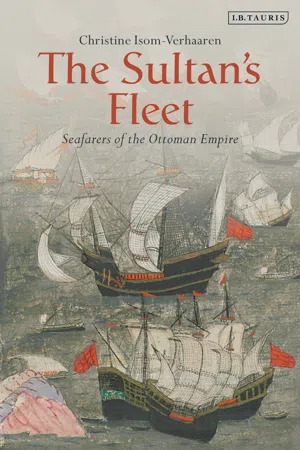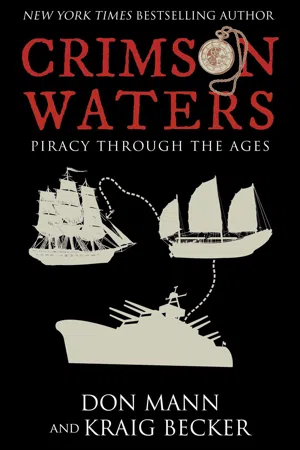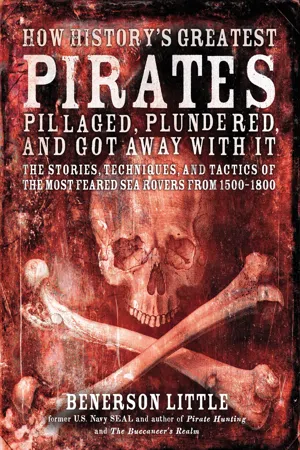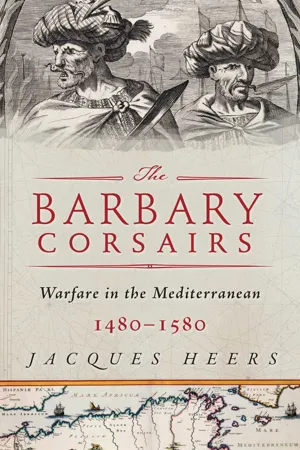History
Hayreddin Barbarossa
Hayreddin Barbarossa was a famous Ottoman admiral and pirate who dominated the Mediterranean Sea during the 16th century. He was known for his naval skills and his successful campaigns against the Spanish and Italian fleets. He also played a significant role in expanding the Ottoman Empire's influence in North Africa.
Written by Perlego with AI-assistance
Related key terms
Related key terms
1 of 4
Related key terms
1 of 3
4 Key excerpts on "Hayreddin Barbarossa"
- eBook - ePub
The Sultan's Fleet
Seafarers of the Ottoman Empire
- Christine Isom-Verhaaren(Author)
- 2021(Publication Date)
- I.B. Tauris(Publisher)
5 Ottoman Seafarers Hayreddin Barbarossa: The Gazi Pasha You are my useful and trusted servant. I rely on your piety and sound judgment in all matters. In the past you attacked those areas in the course of holy war. You know everything about the infidels and their lands. Because I rely on you completely, I placed you in command over all aspects of the imperial fleet. Order from Süleyman to Hayreddin Pasha, Hüküm 1, sent summer of 1543 while Hayreddin commanded the Ottoman fleet off the coast of France. 1 In the summer of 1543, a great Ottoman fleet of over 100 galleys sailed into the French harbor of Toulon, with its banners flying, greeted joyously by the French, whose king, Francis I, had requested its assistance against his rival Charles V, king of Spain and Holy Roman Emperor. This fleet was commanded by the Ottoman admiral Hayreddin Pasha, known to the French and their Habsburg enemies as Barbarossa (Redbeard). Hayreddin, like his fellow seafarer Piri Reis, had gained experience as a corsair in North Africa, where he and his brother Oruç carved out their own mini state at Algiers before Oruç’s death in battle fighting the Spanish in 1518. Hayreddin and Oruç, like Kemal Reis and Piri, traced their origins to the heartlands of the Ottoman Empire, coming from Lesbos, where their father had served as a sipahi (cavalryman) on the island. In 1520 Hayreddin had placed Algiers under Ottoman rule and in 1533 he had been summoned by Süleyman to serve as his admiral, returning to the center of Ottoman power. By 1543, Hayreddin’s fame was already immense since in 1538 he had led the Ottoman naval forces to victory at the battle of Prevesa against the combined fleets of Venice and Spain under his chief naval rival, Andrea Doria. Süleyman’s admiral, Hayreddin Pasha, was able to display Ottoman naval superiority against Süleyman’s imperial rival, Charles V - eBook - ePub
Crimson Waters
Piracy Across the Ages
- Don Mann, Kraig Becker(Authors)
- 2022(Publication Date)
- Skyhorse(Publisher)
The following years saw the Ottoman Empire join forces with the French against their common enemy of Spain. Always the loyal and trustworthy servant, Barbarossa once again set sail at the request of the sultan. By 1543, his fleet had swollen to over two hundred ships and he had more than thirty thousand troops under his command. This was enough to capture a number of important targets in Italy, and even threaten Rome itself. He may have taken the city too, had his new allies not stepped in. Unable to allow the Vatican to be captured by a Muslim army, the French intervened, asking Barbarossa to turn back. Hisir obliged the request, leaving the seat of Catholic power unscathed.From 1543 to 1545, the notorious Barbarossa once again brought a reign of terror across the Mediterranean. His fleet ranged far and wide, attacking outposts from Greece to Spain and back again. However, he was approaching the age of sixty and was beginning to slow down. A long life of travel, adventure, politics, and warfare had taken its toll and he was ready to finally be at peace. Upon returning to Istanbul after his final campaign, the great privateer who had risen to become grand admiral retired at long last. He built himself a palace in the city and took up residence there, enjoying a quiet and peaceful lifestyle until his death the following year.The Barbarossa brothers are a prime example of privateers who were branded as pirates by their enemies. In terms of military victories, Oruç and Hisir might be the most successful pirates in history, sacking towns and enemy ships for more than fifty years. During that time, they became known as some of the most fearsome and bold sailors to ever take to the seas. They were rarely bested in combat and seldom forced to give quarter.Their keen military minds not only served them well throughout their careers, but also benefited the Ottoman Turks greatly. The empire owed them a great debt of gratitude for not only helping it expand into Northern Africa, but also for serving as the first line of defense against their European adversaries for the better part of five decades. Without the Barbarossa brothers leading the way, it is possible that the Ottoman Empire would have been a very different place, both in geographical size and duration. - eBook - ePub
How History's Greatest Pirates Pillaged, Plundered, and Got Away With It
The Stories, Techniques, and Tactics of the Most Feared Sea Rovers from 1500-1800
- Benerson Little(Author)
- 2010(Publication Date)
- Fair Winds Press(Publisher)
Yet Barbarossa will always be known foremost as a corsair, as a swift, deadly, plundering warrior of the sea. For almost three centuries after his death, Turkish and Barbary corsairs practiced his tactics successfully along Christian coasts as far as the North Sea. Although his corsair galliots and galleys are long gone, and also the fear that stirred in many at the sight of them, the wake they left behind is not. - eBook - ePub
The Barbary Corsairs
Pirates, Plunder, and Warfare in the Mediterranean, 1480-1580
- Jacques Heers(Author)
- 2018(Publication Date)
- Skyhorse(Publisher)
13 Italy Threatened, 1530–5Barbarossa was no longer acting as a corsair, mounting raids and punitive expeditions. Instead his ambition had launched him beyond the Tyrrhenian Sea and his major concern revolved around securing the Maghreb kingdoms. He was, of course, an officer of the Sultan, and directly under his orders, and he was an Ottoman enforcer, despatched to overcome rebellion, defeat enemies in the Balkans, or fight the Christians in the Mediterranean. He organised and commanded fleets and armies and he formed or broke alliances.As lieutenant-general of the Ottoman navy, receiving a pension of 2,000 ducats, he oversaw the building of an entirely new fleet – one better than any the Turks had previously launched. Built with wood from Anatolia, iron from Bulgaria, hemp from the Crimea and Greece, oakum from Macedonia, and tallow from Thrace, this fleet was constructed by talented artisans. Heavily armed galleys – each with three decks, and with their hulls protected by sheets of lead – were produced by the dozen. On 21 June 1534 Barbarossa’s own magnificent fleet of forty such galleys weighed anchor and sailed forth. His mission was, it was said, inspired by Grand Vizier Ibrahim’s desire to capture Giulia da Gonzaga, widow of Vespasian Colonna, lord of Fondi, and carry her off for his harem. This beauty, much celebrated among western magnates, had gathered a circle of philosophers, poets, and artists about herself at Fondi, and it was there that Barbarossa launched his initial assault. Legend has it that Giulia escaped miraculously, half naked. Truth is rather more prosaic – sources show that she was in fact at Sperlonga, not Fondi, on the night of the attack. She hastily fled from the castle there, seeking refuge in the night. Much later a nineteenth-century engraving would show her mounted on a black horse at the head of a band of soldiers, dressed in white and illuminated by the glow of fires, sword in hand. A strange image indeed of a woman who would end her days in a Roman convent.14
Index pages curate the most relevant extracts from our library of academic textbooks. They’ve been created using an in-house natural language model (NLM), each adding context and meaning to key research topics.
Explore more topic indexes
Explore more topic indexes
1 of 6
Explore more topic indexes
1 of 4



